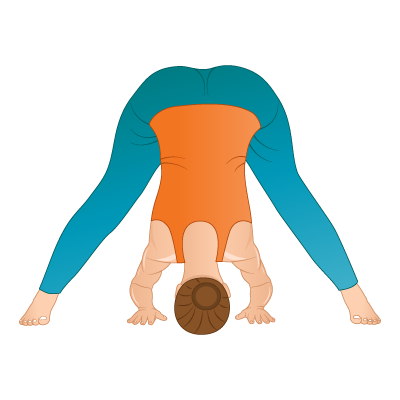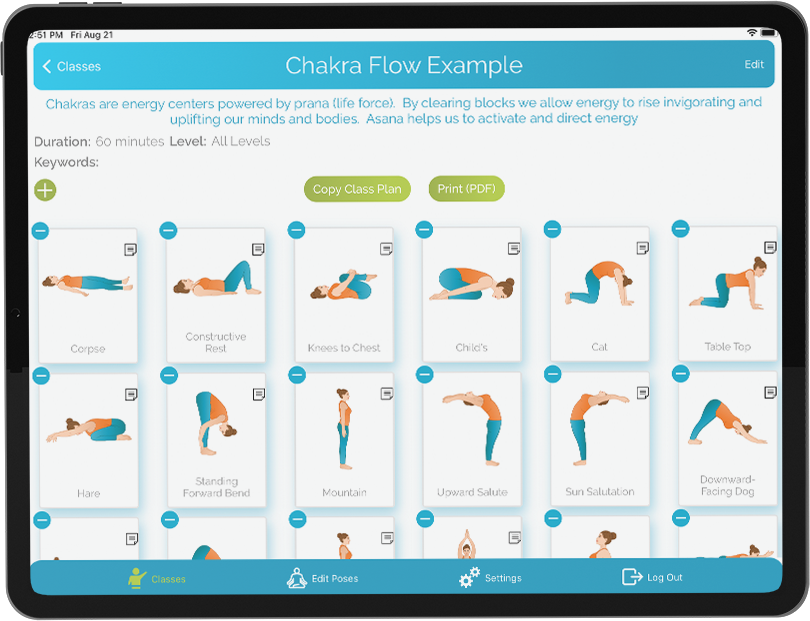Wide-Legged Forward Bend
Prasarita Padottanasana

STEPS
Begin from Tadasana (Mountain Pose). Take a big step back, approximately 3 1/2 -4 feet, with the right foot. Pivot on the mat so that both feet are facing the long edge of the mat, in a parallel position. The outside edges of the feet are parallel with the short edge of the mat. Firm the legs muscles and lift through the arches of the feet. Place the hands on the hips. Inhale to lengthen the spine towards the ceiling and exhale to hinge from the hips, folding forward towards the thighs. Reach the hands to the floor and inhale to lengthen the spine again, finding a long neutral back, not rounding the spine (see modifications), exhale, to hinge deeper into the posture. Keep the legs engaged as the upper body releases forward. Keep the palms pressing into the floor and bring the crown of the head towards the ground. Hold the posture for 5 to 10 breaths. to come up, place the hands onto the hips again, engage the inner thighs and inhale to lengthen the spine back up to standing.
TEACHER QUEUES
VISUALIZATION COMMENTS
This posture is immensely invigorating. It strengthens and stretches the inner thighs and hamstrings and brings vitality to the spine by releasing tension. Invite students to give into this pose, allowing the head to hang and the neck to release. Literally imagine brain tension tumbling out the top of the head. Focus on the body and breath!
TECHNICAL COMMENTS
Though this posture is not inherently complicated, it dies require some fundamental principles to remain in good alignment. Once the legs are wide bring focus to the feet. It is important to remain lifted in the arches, keeping the weight even from the big toe mound to the baby toe mound. With the hands on the hips, tip the pelvis forward and feel the sitting bones lift up to point back, creating a long spine without rounding in the lumbar. As the upper body comes forward, the hands can reach to the ground. Lift up on the fingertips and reach the head and tail away from each other. Make sure the weight is even in the feet and the kneecaps are lifted to engage the quadriceps. If the spine rounds at their point, of there is difficulty coming to the floor, see modifications. If yoga re moving deeper into the pose, place the palms on the floor and bring the torso lower, maintaining a long spine. With the palms on the floor, draw the shoulders down against gravity to lengthen the next and feel the muscles on the back. The crown of the head may come to the floor. It is does, walk the hands deeper between the legs, maintaining the shoulders on the back. To come out of the pose, gently squeeze the inner thighs to help activate the core while coming back up.
BENEFIT COMMENTS
- stretches and strengthens inner thighs and back of legs
- stretches the back
- energizing
- releases neck tension
- stimulates digestive organs
WATCH OUT FOR
- ankles rolling in or out
- knees locking
- sitting back in the hips and heels
- rounding the lumbar spine
- tension in the neck
CONTRAINDICATIONS
- Use caution with lower back problems (see modifications)
- High blood pressure (half way only)
- Low blood pressure, come out slowly
MODIFICATIONS
- Use a block to place the palms on
- place the palms on a wall
- Bend the knees
VARIATIONS
- At the bottom of the posture hook the index and middle finer around the big toe in a yogi grip. Bend the elbows and gently draw the body further forward.
- In standing, interlace the fingers behind the back, draw the shoulder blades together. Hinge forward and extend the arms over the head towards the floor.
- Place one palm on the floor (or on a block) beneath the torso in the fold. Lengthen the spine from the tail and head and gently twist the upper body towards the ceiling. Keep the hips square. Extend the top arm towards the ceiling. Gently release and repeat on the opposite side.
- Keep the hands on the hips through out the posture.
YOGA COUNTER POSES
- Mountain Pose (Tadasana)
- Fierce (Chair) Pose (Utkatasana)
- Warrior I, II (Virabhadrasana I, II)
- Eagle Pose (Garudasana)
Written By: Meghan Aris
Certified in several disciplines of yoga, a pilates teacher and teacher trainer, Meghan is continually widening her path of body/mind studies. At a young age she began her journey into body movement through dance. After being diagnosed with Rheumatoid Arthritis, she shifted her practice to more rehabilitative yoga. In this discipline she found not only the resources to heal her body, but also a guide to living a life full of peace and joy. She can be found teaching on any given day at Fix Health Care



